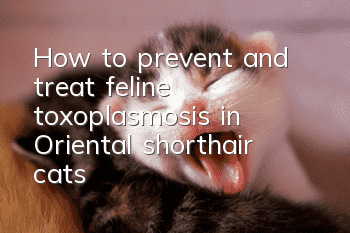How to prevent and treat feline toxoplasmosis in Oriental shorthair cats

How to prevent and treat feline toxoplasmosis in Oriental shorthair cats? Toxoplasmosis is a zoonotic protozoal disease caused by Toxoplasma gondii of the genus Toxoplasma in the family Sarcocystidae. It is characterized by the parasitic parasite In all nucleated cells in the intermediate host.
Toxoplasma gondii has different shapes at different stages of development. Trophozoites and cysts appear in the intermediate host; schizonts, gametocytes and oocysts only appear in the definitive host. . There are many intermediate hosts, including more than 200 species of animals including humans, mammals, birds, fish and reptiles, including cats. The definitive host is felines, so cats are both the intermediate host and the definitive host of Toxoplasma gondii. Trophozoites, also known as tachyzoites, are mainly seen in acute cases of intermediate hosts. They are crescent-shaped with a blunt end and a sharp end, with a size of 4 to 7 microns × 2 to 4 microns. Cysts, also known as tissue cysts, are seen in chronic cases of intermediate hosts. They are subspherical in shape, with a maximum diameter of 100 microns. The cysts contain several or even thousands of trophozoites. At this time, the trophozoites are in a dormant state, also known as bradyzoites. Oocysts are found in feline feces and are round or oval in shape with two layers of egg walls and an average size of 10 microns × 12 microns
The oocysts excreted with cat feces will complete sporulation in several days under suitable conditions. When a cat ingests sporulated oocysts and cysts in the muscles, internal organs and other tissues of infected animals, sporozoites, bradyzoites and tachyzoites invade the villus epithelial cells of the cat's small intestine and undergo coccidial phase development. , and finally produce oocysts, which are excreted in the feces. Cats are also intermediate hosts. The spores, bradyzoites and tachyzoites can enter the human lymph and blood just like they parasitize in other intermediate hosts, spread to the tissues of various organs throughout the body, and invade nucleated cells for arching. The insect phase develops and is preserved in the body. In addition, cats can also be infected with toxoplasmosis through the placenta, respiratory tract, skin wounds, etc.
Treatment often uses sulfa drugs and pyrimethamine, 10 mg per kilogram of body weight, orally administered pyrimethamine 4 to 6 times a day, and 0.5 to 1.0 mg per kilogram of body weight, orally administered once a day. The above two drugs are more effective when combined. In order to prevent side effects of the drug, tetrahydrofolate phthalate can be taken at the same time, 1 mg per kilogram of body weight per day.
Pay attention to environmental hygiene, keep the environment clean and dry, dispose of feces in a timely manner, avoid feeding raw meat, milk, and eggs, and conduct regular fecal examinations.
- Is hair loss serious with golden gradient layer?
- How to adapt fold-eared cats to training
- Can a cat eat pigeon meat?
- Learn about these three common causes of blood in your cat’s poop
- How long does it take for a cat to give birth after shedding secretions?
- How many days does it take for a cat to adapt to a new owner and new environment?
- At what age can cats eat catnip? When can cats eat catnip?
- Cat keeps meowing after being locked in cage
- Why does a cat vomit white foam?
- Does a cat still recognize its owner after not seeing him for a year?



